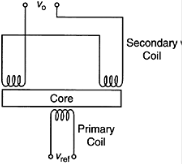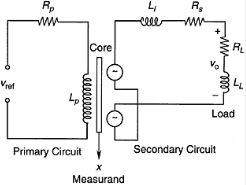SKEDSOFT
Phase Shift and Null Voltage
An error known as null voltage is present in some differential transformers. This manifests itself as a nonzero reading at the null position (i.e., at zero displacement).
This is usually 90° out of phase from the main output signal and, hence, is known as quadrature error. Non uniformities in the windings (unequal impedances in the two segments of the secondary winding) are a major reason for this error.
The null voltage may also result from harmonic noise components in the primary signal and nonlinearities in the device. Null voltage is usually negligible (typically about 0.1% of the full scale).


This error can be Equivalent circuit for a differential transformer.
Eliminated from the measurements by employing appropriate signal-conditioning and calibration practices.
The output signal from a differential transformer is normally not in phase with the reference voltage.
Inductance in the primary coil and the leakage inductance in the secondary coil are mainly responsible for this phase shift. Since demodulation involves extraction of the modulating signal by rejecting the carrier frequency component from the secondary signal, it is important to understand the size of this phase shift.






